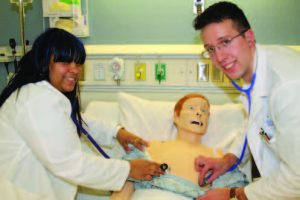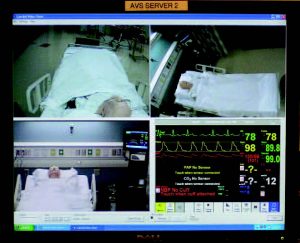High-tech mannequins keep Trinitas nursing students on the cutting edge.
By Diane Alter
Remember the Mannequin Challenge, the viral phenomenon that swept the nation in 2016?Well, that was nothing new to the Trinitas School of Nursing (TSON). Mannequins have been teaching and challenging TSON students since 2005, when the first high-fidelity patient simulator arrived. It was called SimMan and it was developed by Laerdal Medical Corporation. Since then the nursing school’s population of high-fidelity patient simulators has steadily grown. The school’s faculty has become increasingly adept at using these medical mannequins to demonstrate key aspects of safe patient care and teach students how to respond to emergency situations.
TSON’s Learning/Simulation Center is currently equipped with 23 high, medium and low-tech patient simulators.
 Seven are high-fidelity computer-operated mannequins that have heartbeats, can breathe, talk, sweat and simulate a wide range of medical conditions and responses to treatment. Two are birthing simulators that can simulate the birth of a baby and the complications of pregnancy and childbirth. Also featured in the lab are part-task simulation trainers. These are smaller simulation pieces of equipment that mimic specific parts of the human body. They are used to practice delicate procedures, such as intravenous therapy, urinary catheterization and colostomy care.
Seven are high-fidelity computer-operated mannequins that have heartbeats, can breathe, talk, sweat and simulate a wide range of medical conditions and responses to treatment. Two are birthing simulators that can simulate the birth of a baby and the complications of pregnancy and childbirth. Also featured in the lab are part-task simulation trainers. These are smaller simulation pieces of equipment that mimic specific parts of the human body. They are used to practice delicate procedures, such as intravenous therapy, urinary catheterization and colostomy care.
“The benefits of using the mannequins for teaching are many,” Donna Penn, Dean of the Trinitas School of Nursing, says. “The students practice skills and techniques. They also learn how to communicate, problem-solve, and engage in critical thinking—all in a very safe and controlled environment. The mannequins provide an interactive environment that permits hands-on experience where students can make mistakes and learn and grow from them.”
Assistant Deans Monina Franco-Tantuico and Rose Santee explain that the mannequins also allow students to reflect and think back on what they did right or wrong, and change their behavior as needed. The devices also allow teachers to create scenarios that students will hopefully never see, but if and when they do, they will have received training on how to react.
“It is a very effective and modern way to teach,” says Franco-Tantuico.
“It makes all of us think more, and it keeps us all on our toes,” adds Santee.
 The Learning/Simulation Center also includes a digital audio-visual system that transmits and records situations in a simulated environment to facilitate learning. Control rooms for the simulation area permit instructors and computer specialists to remotely operate the mannequins. An adjacent debriefing room enables instructors and students to review the video recording of the simulated scenario and engage in a reflective discussion of what occurred during that simulation. The Learning/Simulation Center is just one more example of how TSON continues to enhance students’ learning environment and promote professional growth.
The Learning/Simulation Center also includes a digital audio-visual system that transmits and records situations in a simulated environment to facilitate learning. Control rooms for the simulation area permit instructors and computer specialists to remotely operate the mannequins. An adjacent debriefing room enables instructors and students to review the video recording of the simulated scenario and engage in a reflective discussion of what occurred during that simulation. The Learning/Simulation Center is just one more example of how TSON continues to enhance students’ learning environment and promote professional growth.
The school’s commitment to excellence is continually recognized and rewarded. TSON was yet again designated as a National League for Nursing Center of Excellence (COE) for 2015-2020 in the category of “Creating Environments that Enhance Student Learning and Professional Development.” This marks the third consecutive COE designation in this category since 2008.





